Hot Strip Mill Gearbox Monitoring and Diagnosis Based on Convolutional Neural Networks Using the Pseudo-Labeling Method
Abstract
:1. Introduction
2. Related Works
3. A Monitoring Procedure for Equipment Status
3.1. Methods for Capturing Changes in Equipment Status
3.2. Monitoring for Equipment Abnormality
4. Theoretical Background
4.1. Continuous Wavelet Transform
4.2. Convolutional Neural Networks
4.3. Overview of Model Performance Evaluation Metrics
5. Experiment Validation
5.1. Data Acquisition and Pre-Processing
5.2. Image Extraction and CNN Design
5.2.1. Convolution Layer
5.2.2. Pooling Layer
5.2.3. Dropout Layer
5.2.4. Fully Connected Layer Layer
5.2.5. Regulation of Over-Fitting
5.3. Experiment Results
6. Discussion and Conclusions
Author Contributions
Funding
Institutional Review Board Statement
Informed Consent Statement
Data Availability Statement
Conflicts of Interest
Abbreviations
| AI | Artificial Intelligence |
| ML | Machine Learning |
| Cp | Change point |
| CWT | Continuous Wavelet Transform |
| CNN | Convolutional Neural Network |
| CMS | Condition Monitoring System |
| DCP | Change point Difference |
| DS | Drive Side |
| NDS | Non-Drive Side |
| PN | Pseudo-Normal |
| PA | Pseudo-Abnormal |
| FC | Fully Connected Layer |
| ReLU | Rectified Linear Unit |
| SVM | Support Vector Machine |
| AE | Auto Encoder |
| LSTM | Long Short-Term Memory |
| ODR | Omnidirectional regenerator |
| GMM | Gaussian Mixture Model |
| JTFA | Joint Time-Frequency Analysis |
| FEMP | The Federal Energy Management Program |
| WT | Wavelet Transform |
References
- Yacout, S. Fault detection and Diagnosis for Condition Based Maintenance Using the Logical Analysis of Data. In Proceedings of the 40th International Conference on Computers and Industrial Engineering Computers and Industrial Engineering (CIE), Awaji, Japan, 25–28 July 2010; pp. 1–6. [Google Scholar]
- Farina, M.; Osto, E.; Perizzato, A.; Piroddi, L.; Scattolini, R. Fault detection and isolation of bearings in a drive reducer of a hot steel rolling mill. Control Eng. Pract. 2015, 39, 35–44. [Google Scholar] [CrossRef]
- Jardine, A.K.S.; Lin, D.; Banjevic, D. A review on machinery diagnostics and prognostics implementing condition-based maintenance. Mech. Syst. Signal Process. 2006, 20, 1483–1510. [Google Scholar] [CrossRef]
- Chen, Z.; Li, C.; Sanchez, R.V. Gearbox fault identification and classification with convolutional neural networks. Shock Vib. 2015, 2015, 390134. [Google Scholar] [CrossRef]
- Jing, L.; Zhao, M.; Li, P.; Xu, X. A CNN based feature learning and fault diagnosis method for the condition monitoring of gearbox. Measurement 2017, 111, 1–10. [Google Scholar] [CrossRef]
- Seo, M.K.; Yun, W.Y. Clustering-based monitoring and fault detection in hot strip rolling mill. J. Korean Soc. Qual. Manag. 2017, 45, 298–307. [Google Scholar] [CrossRef]
- Seo, M.K.; Yun, W.Y. Clustering-based hot strip rolling mill diagnosis using Mahalanobis distance. J. Korean Inst. Ind. Eng. 2017, 43, 298–307. [Google Scholar]
- Lee, J.W.; Chon, H.S.; Kwon, D.I. Research trends and analysis in the field of fault diagnosis. Korean Soc. Mech. Eng. (Mech. J.) 2016, 56, 37–40. [Google Scholar]
- Lee, T.H.; Yu, E.S.; Park, K.Y.; Yu, S.S.; Park, J.P.; Mun, D.W. Detection of Abnormal Ship Operation using a Big Data Platform based on Hadoop and Spark. Korean Soc. Manuf. Process Eng. 2019, 18, 82–90. [Google Scholar] [CrossRef]
- Heng, A.; Zhang, S.; Tan, A.C.C.; Matthew, J. Rotating machinery prognostics: State of the art, challenges and opportunities. Mech. Syst. Signal Process. 2009, 23, 724–739. [Google Scholar] [CrossRef]
- Ince, T.; Kiranyaz, S.; Eren, L.; Askar, M.; Gabbouj, M. Real-time motor fault detection by 1-D convolutional neural networks. IEEE Trans. Ind. Electron. 2016, 63, 7067–7075. [Google Scholar] [CrossRef]
- Lupea, L.; Lupea, M. Detecting Helical Gearbox Defects from Raw Vibration Signal Using Convolutional Neural Networks. Sensors 2023, 23, 8769. [Google Scholar] [CrossRef] [PubMed]
- Hu, P.; Zhao, C.; Huang, J.; Song, T. Intelligent and Small Samples Gear Fault Detection Based on Wavelet Analysis and Improved CNN. Processes 2023, 11, 2969. [Google Scholar] [CrossRef]
- Abdeljaber, O.; Avci, O.; Kiranyaz, S.; Gabbouj, M.; Inman, D.J. Real-time vibration-based structural damage detection using one-dimensional convolutional neural networks. J. Sound Vib. 2017, 388, 154–170. [Google Scholar] [CrossRef]
- Park, J.S. Wafer map-based defect Detection Using Convolutional Neural Networks. J. Korean Inst. Ind. Eng. 2018, 44, 249–258. [Google Scholar]
- Perera, L.P.; Brage, M. Data analysis on marine engine operating regions in relation to ship navigation. Ocean Eng. 2018, 128, 163–172. [Google Scholar]
- Jeong, H.; Park, S.; Woo, S.; Lee, S. Rotating machinery diagnostics using deep learning on orbit plot images. Procedia Manuf. 2016, 5, 1107–1118. [Google Scholar] [CrossRef]
- Jung, J.H.; Jeon, B.C.; Youn, B.D.; Kim, M.; Kim, D.; Kim, Y. Omnidirectional regeneration (ODR) of proximity sensor signals for robust diagnosis of journal bearing systems. Mech. Syst. Signal Process. 2017, 90, 189–207. [Google Scholar] [CrossRef]
- Gao, D.; Zhu, Y.; Wang, X.; Yan, K.; Hong, J. A fault diagnosis method of rolling Bearing Based on Complex Morlet CWT and CNN. In Proceedings of the Prognostics and System Health Management Conference (PHM-Chongqing), Chongqing, China, 26–28 October 2018; pp. 1101–1105. [Google Scholar]
- Lee, J.H.; Okwuosa, C.N.; Hur, J.W. Extruder Machine Gear Fault Detection Using Autoencoder LSTM via Sensor Fusion Approach. Inventions 2023, 8, 140. [Google Scholar] [CrossRef]
- Ramteke, D.S.; Parey, A.; Pachori, R.G. A New Automated Classification Framework for Gear Fault Diagnosis Using Fourier–Bessel Domain-Based Empirical Wavelet Transform. Machines 2023, 11, 1055. [Google Scholar] [CrossRef]
- Lee, S.H.; Youn, B.D. Industry 4.0 and direction of failure prediction and health management technology (PHM). J. Korean Soc. Noise Vib. Eng. 2015, 21, 22–28. [Google Scholar]
- Pecht, M.G.; Kang, M.S. Prognostics and Health Management of Electronics-Fundamentals Machine Learning, and the Internet of Things; John Wiley and Sons: Hoboken, NJ, USA, 2008; pp. 23–56. [Google Scholar]
- Yang, B.S.; Widodo, A. Introduction of intelligent Machine Fault Diagnosis and Prognosis; Nova Science Publishers: Hauppauge, NY, USA, 2009; pp. 23–76. [Google Scholar]
- Choi, J.H. A review on prognostics and health management and its application. J. Aerosp. Syst. Eng. 2014, 38, 7–17. [Google Scholar]
- Philip, M.G.; Richard, J.G.; John, I.H. Fundamentals of Fluid Mechanics; Addison-Wesley: Boston, MA, USA, 2009. [Google Scholar]
- Liang, P.L.; Chao, W.; Jun, Y.; Zhixin, Y. Intelligent fault diagnosis of rotating machinery via wavelet transform, generative adversarial nets and convolutional neural network. Measurement 2020, 159, 107768. [Google Scholar] [CrossRef]
- Huang, L.; Wang, J. Forecasting energy fluctuation model by wavelet decomposition and stochastic recurrent wavelet neural network. Neurocomputing 2018, 309, 70–82. [Google Scholar] [CrossRef]
- Lee, J.W.; Lee, H.W.; Yoo, C.S. Selection of mother wavelet for bivariate wavelet analysis. J. Korea Water Resour. Assoc. 2019, 52, 905–916. [Google Scholar]
- Liu, T.; Fang, S.; Zhao, Y.; Wang, P.; Zhang, J. Implementation of training convolutional neural Networks. arXiv 2015, arXiv:1506.01195. [Google Scholar]
- Chollet, F. Deep Learning with R; Manning: Shelter Island, NY, USA, 2018. [Google Scholar]
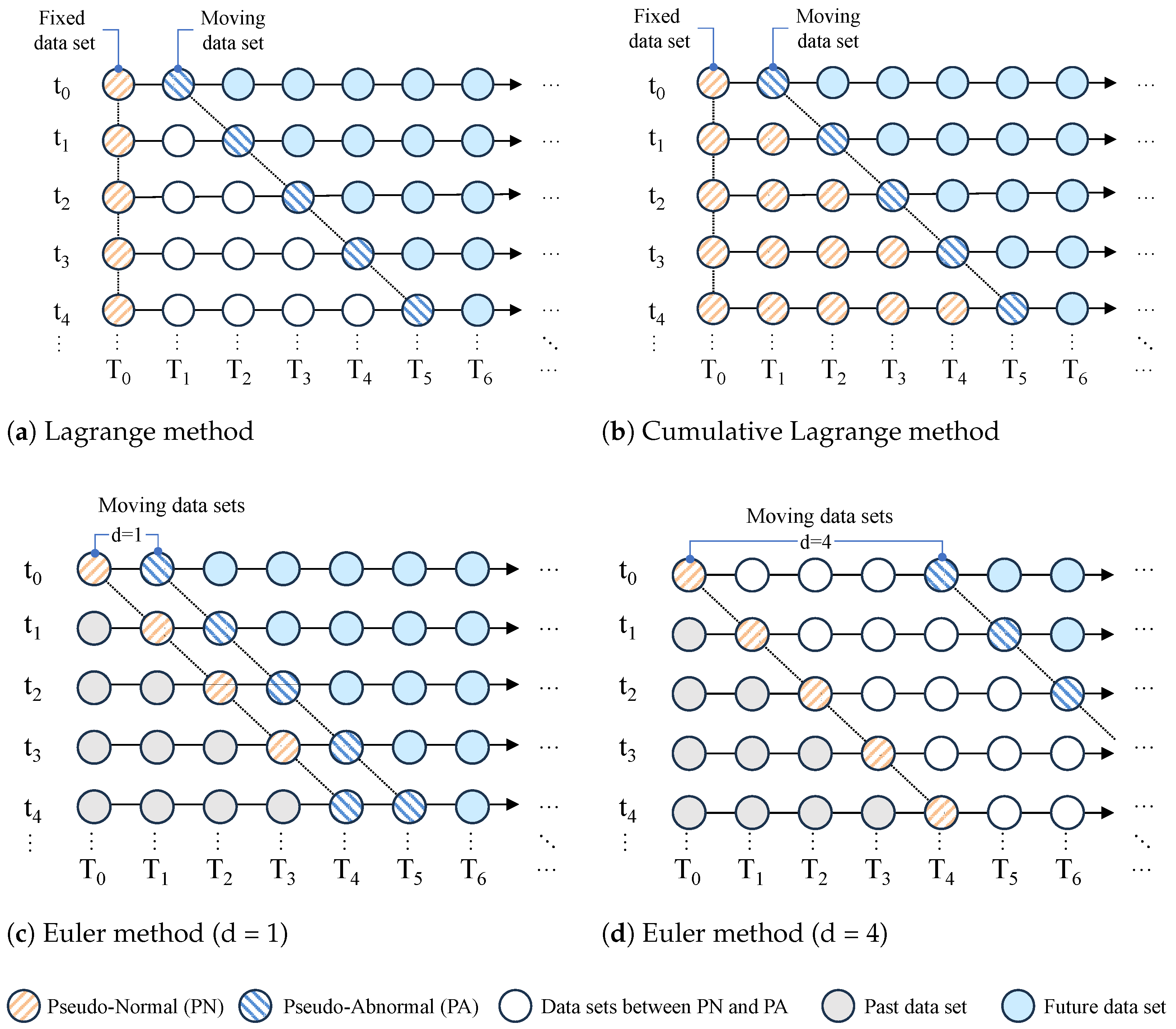



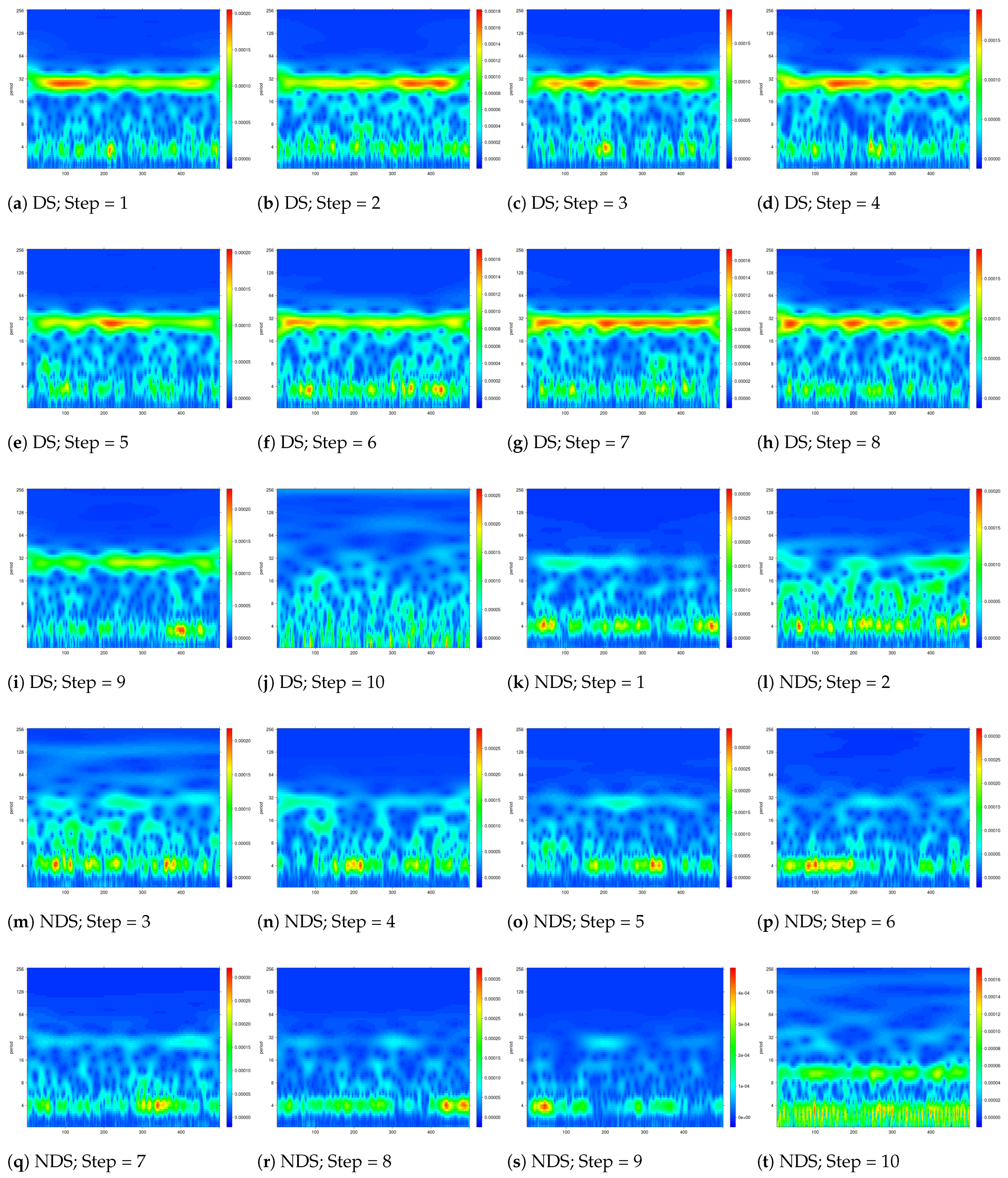

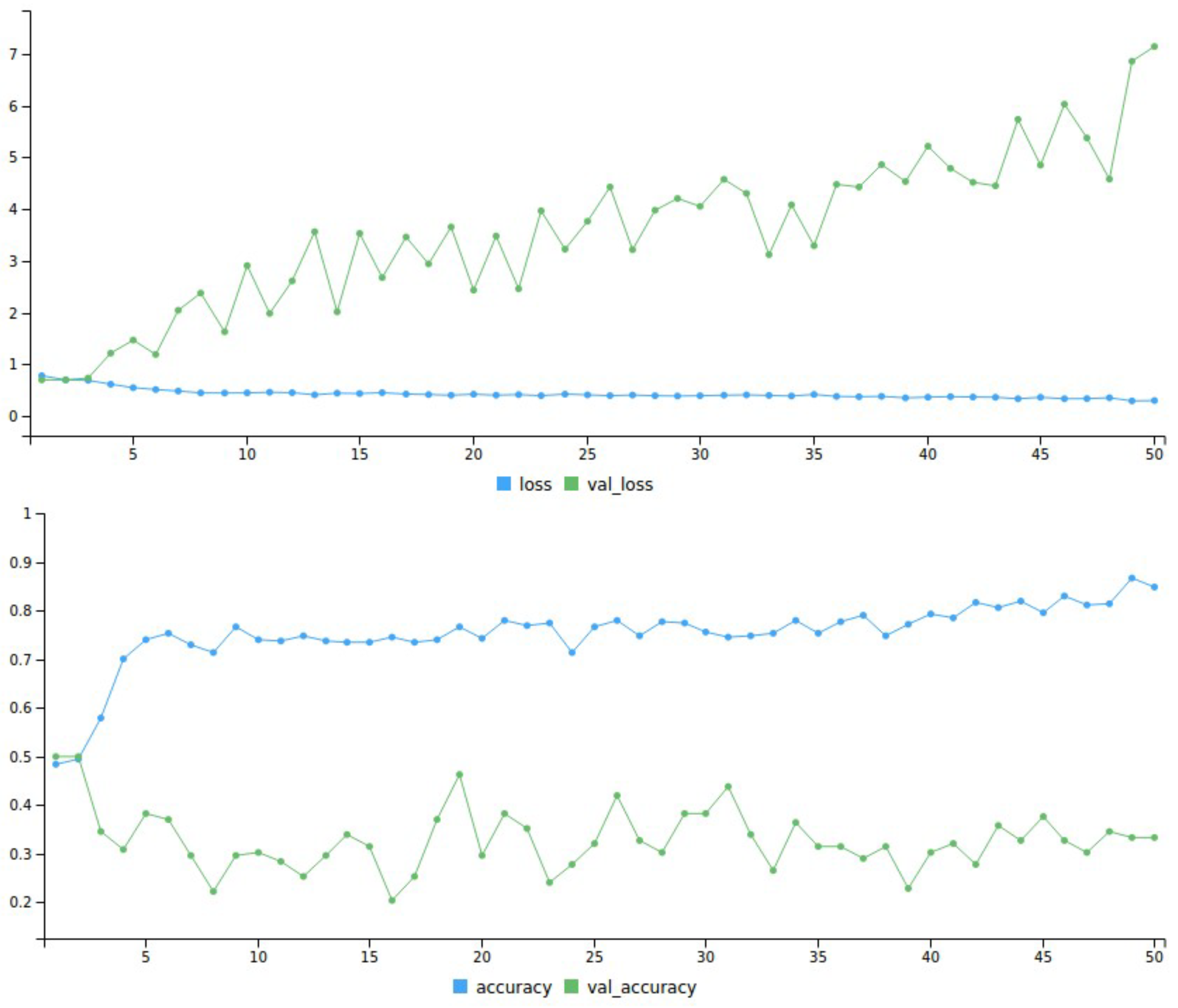

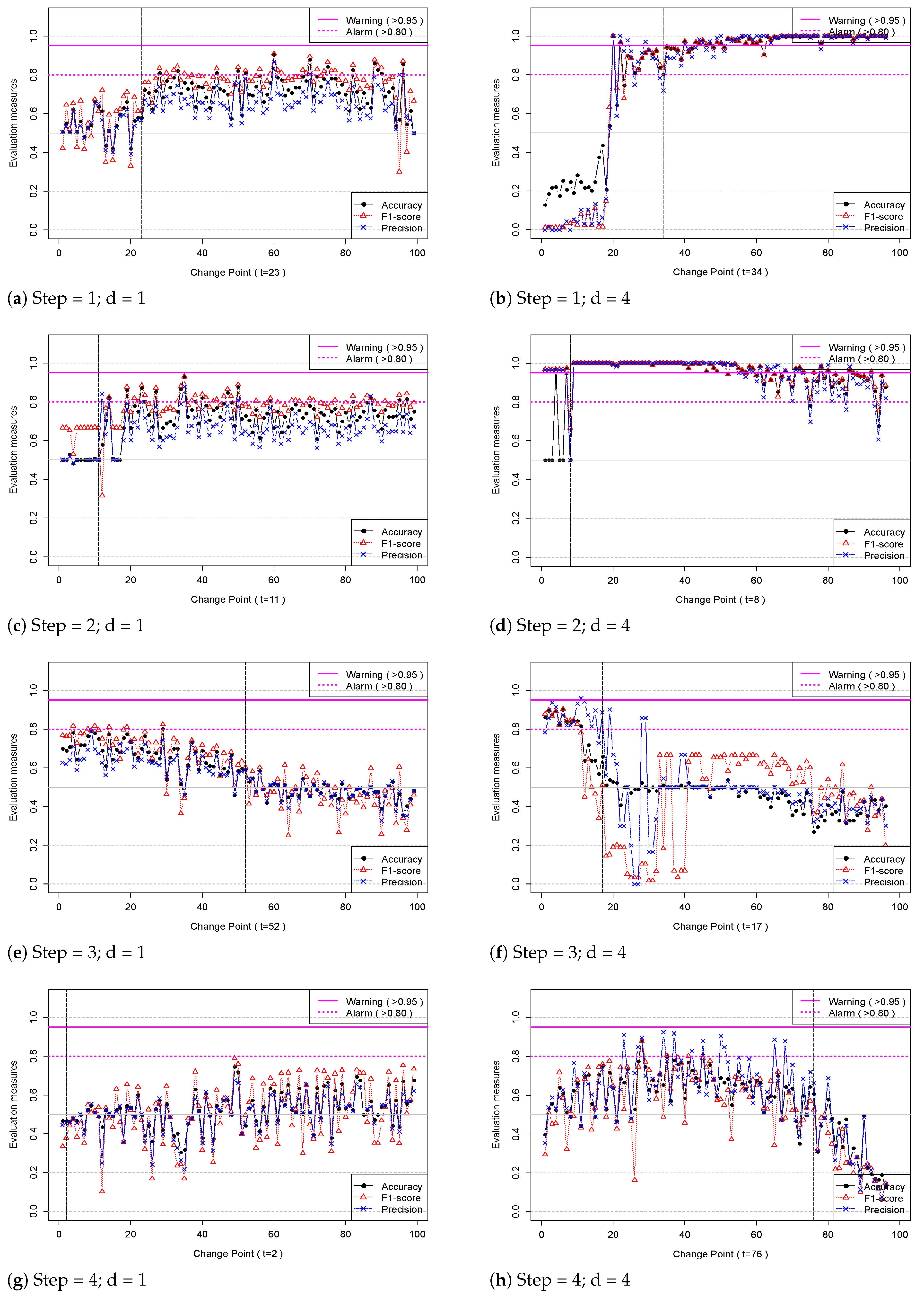
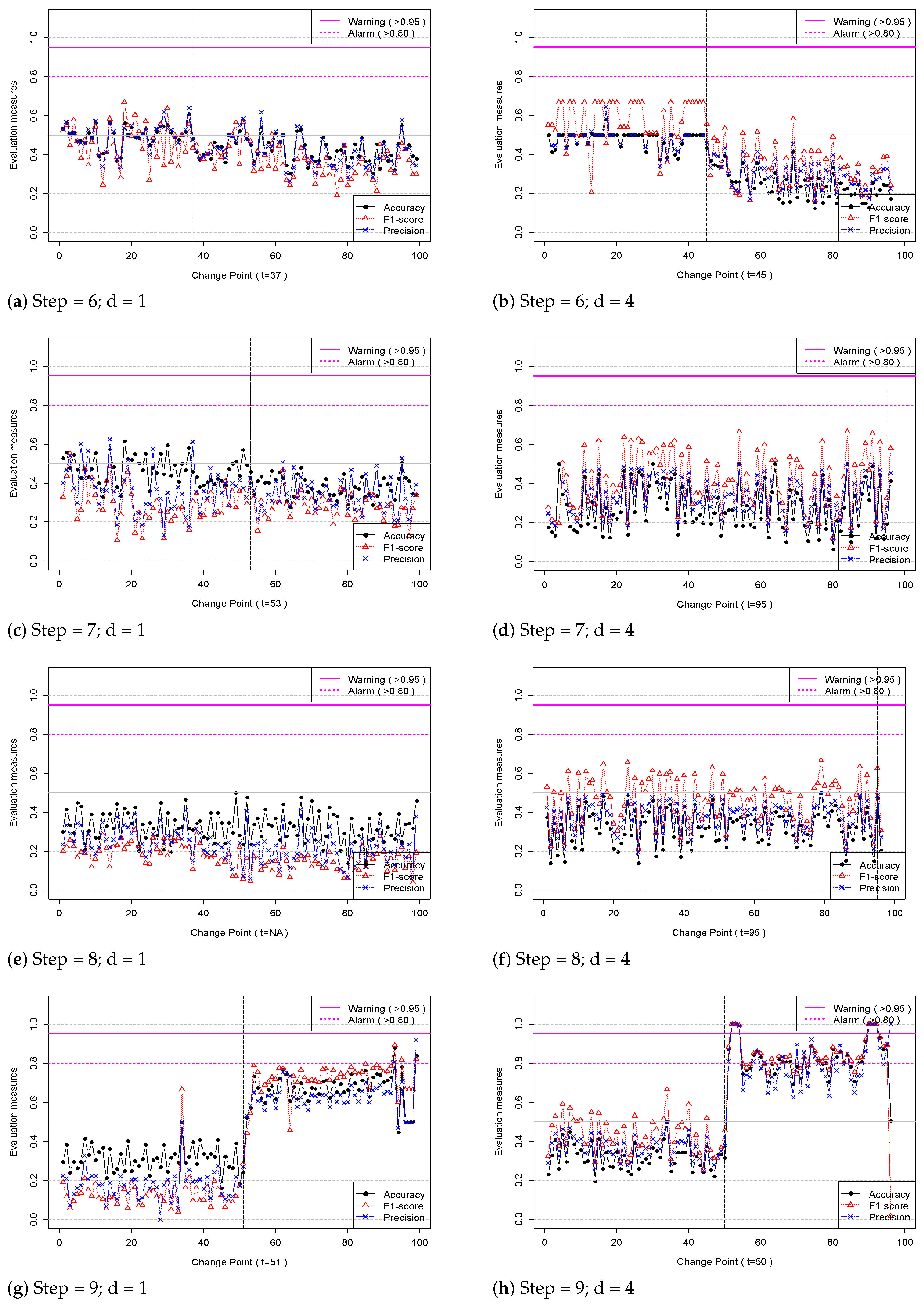
| Layer (Type) | Output Shape | Parameter * | Activation Function |
|---|---|---|---|
| conv2d_15 (Conv2D) | (None, 123, 123, 32) | 3488 | ReLU |
| max_pooling2d_15 (MaxPooling2D) | (None, 41, 41, 32) | 0 | - |
| conv2d_16 (Conv2D) | (None, 38, 38, 60) | 30,780 | ReLU |
| max_pooling2d_16 (MaxPooling2D) | (None, 19, 19, 60) | 0 | - |
| flatten_5 (Flatten) | (None, 21660) | 0 | - |
| dropout_4 (Dropout) | (None, 21660) | 0 | - |
| dense_10 (Dense) | (None, 128) | 2,772,608 | ReLU |
| dropout_5 (Dropout) | (None, 128) | 0 | - |
| dense_12 (Dense) | (None, 64) | 8256 | ReLU |
| dense_10 (Dense) | (None, 2) | 130 | SoftMax |
| Case | Interval Parameter (d) | Step 1 | Step 2 | Step 3 | Step 4 | Step 6 | Step 7 | Step 8 | Step 9 |
|---|---|---|---|---|---|---|---|---|---|
| 23 | 11 | 52 | 2 | 37 | 53 | NA | 51 | ||
| Change Point () | 20 | 8 | 17 | 76 | 45 | 95 | 95 | 50 | |
| 0.1752 | 0.2304 | 0.1891 | 0.0549 | 0.0735 | 0.0904 | 0.0163 | 0.3575 | ||
| Acc. mean difference () | 0.6523 | 0.3424 | 0.3304 | 0.3058 | 0.2359 | 0.0000 | 0.0000 | 0.5060 | |
| 0.9028 | 0.9259 | 0.8009 | 0.7554 | 0.7454 | 0.6065 | 0.6146 | 0.8796 | ||
| Maximum Accuracy () | 1.0000 | 1.0000 | 0.8981 | 0.8796 | 0.5787 | 0.5000 | 0.5000 | 1.0000 | |
| A | A | A | - | - | - | - | A | ||
| A (Alarm) *, W (Warning) * | W | W | A | A | - | - | - | W |
Disclaimer/Publisher’s Note: The statements, opinions and data contained in all publications are solely those of the individual author(s) and contributor(s) and not of MDPI and/or the editor(s). MDPI and/or the editor(s) disclaim responsibility for any injury to people or property resulting from any ideas, methods, instructions or products referred to in the content. |
© 2024 by the authors. Licensee MDPI, Basel, Switzerland. This article is an open access article distributed under the terms and conditions of the Creative Commons Attribution (CC BY) license (https://creativecommons.org/licenses/by/4.0/).
Share and Cite
Seo, M.-K.; Yun, W.-Y. Hot Strip Mill Gearbox Monitoring and Diagnosis Based on Convolutional Neural Networks Using the Pseudo-Labeling Method. Appl. Sci. 2024, 14, 450. https://doi.org/10.3390/app14010450
Seo M-K, Yun W-Y. Hot Strip Mill Gearbox Monitoring and Diagnosis Based on Convolutional Neural Networks Using the Pseudo-Labeling Method. Applied Sciences. 2024; 14(1):450. https://doi.org/10.3390/app14010450
Chicago/Turabian StyleSeo, Myung-Kyo, and Won-Young Yun. 2024. "Hot Strip Mill Gearbox Monitoring and Diagnosis Based on Convolutional Neural Networks Using the Pseudo-Labeling Method" Applied Sciences 14, no. 1: 450. https://doi.org/10.3390/app14010450
APA StyleSeo, M.-K., & Yun, W.-Y. (2024). Hot Strip Mill Gearbox Monitoring and Diagnosis Based on Convolutional Neural Networks Using the Pseudo-Labeling Method. Applied Sciences, 14(1), 450. https://doi.org/10.3390/app14010450





